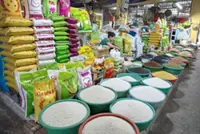A pile of garbage on Hanoi's Hoang Ngan Street. — VNA/VNS
HANOI: A recent report indicates a concerning uptrend in plastic waste across provinces and cities in Vietnam, with HCM City and Hanoi emerging as the primary culprits.
The findings, a collaborative effort between the World Wide Fund for Nature in Vietnam, the Ministry of Natural Resources and Environment, and the Vietnam Administration of Seas and Islands, shed light on the plastic waste situation in Vietnam for 2022, Tien Phong (Vanguard) newspaper reported.





